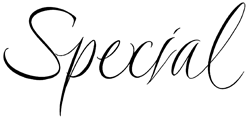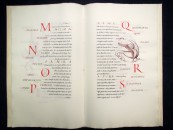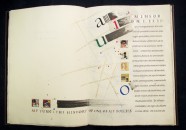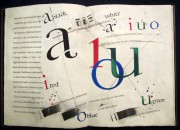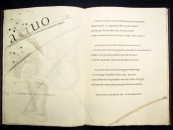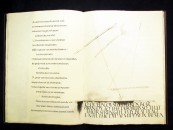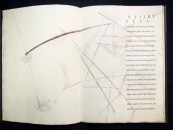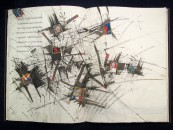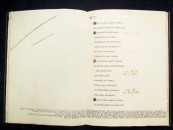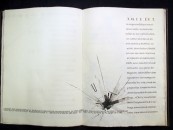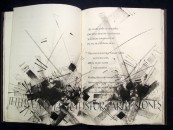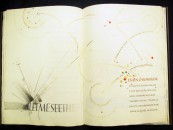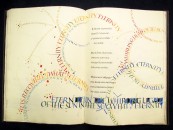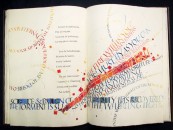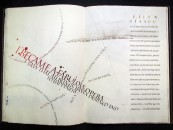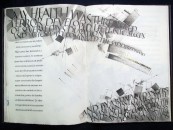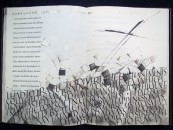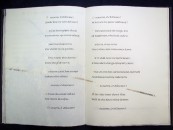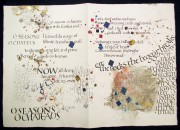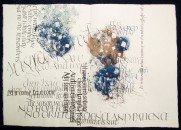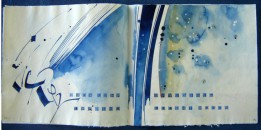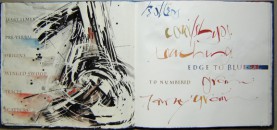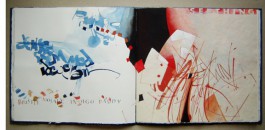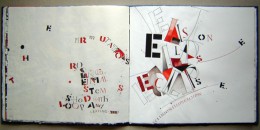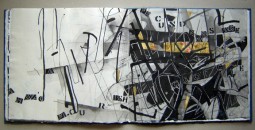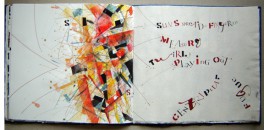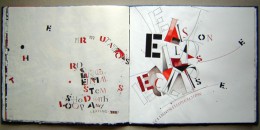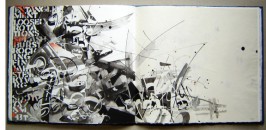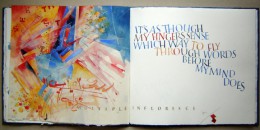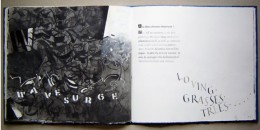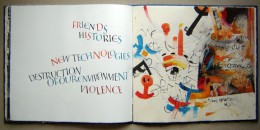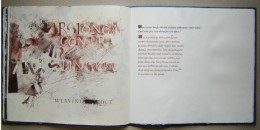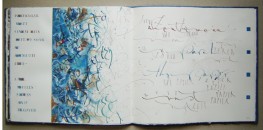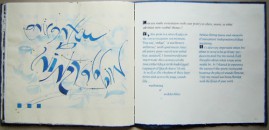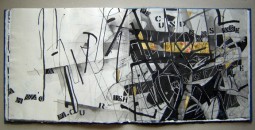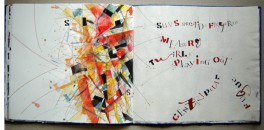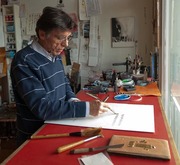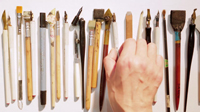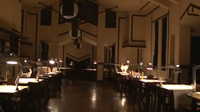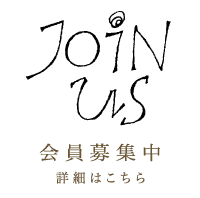CALLIGRAPHY AS AN EXPERIMENT:
Discovering Answers in the Creation of Modern Manuscript Books 〈part 1 of 2 〉
From my earliest days of learning calligraphy I was interested in exploring and finding new ways to think about calligraphy. I loved learning the craft of calligraphy and the practice of traditional alphabets, but yearned to create something new, something of my own. The idea of everything being an experiment guided my work for years.
This feeling obviously was fueled by my prior design and art training in Landscape architecture, but I think was also the result of my living in San Francisco. My home, in close proximity to a large Asian community, presented me with easy opportunities to explore oriental art shops filled with inks, brushes and books on eastern calligraphy. I became quite fascinated with Japanese Zen calligraphy and ultimately in the writing of other non-Western cultures, particularly Arabic. Also Bay Area artists, who I met here, helped to channel my calligraphic explorations. I looked at the “calligraphic paintings” of modern abstract expressionists, such as Franz Kline and Mark Tobey.
All of these influences ultimately led me to exploring calligraphy as visually expressive medium. Rather than a concern for historic form and readability, I wanted to see if I could use lettering to visually capture the feeling, mood, or atmosphere of the text. As a means to experiment with these ideas, I have created a number of unique (one-of-a-kind) books.
The first two books described below were created in the early 1980s and are very traditional in character.
The Bestiary
The Bestiary contains selected text and drawings interpreted from T. H. White’s book, The Book of Beasts, an English translation of a medieval bestiary originally written in Latin. I created this book in 1981 after a brief study of manuscripts at the British Library and the Bodleian Library at Oxford University. The Versal capital letters in the book were copied from a 12th Century manuscript from the Bodleian and the cursive book hand was an interpretation of a humanist writing from the hand of the Medieval master, Felice Feliciano.
Alchimie du Verbe
The text is by Authur Rimbaud, includes formal poetry and prose poetry from the book titled A Season in Hell. The text is written in both the original French as well as the translation in English. The French is in a formal book hand and the English translations, still in various traditional hands, have been used for the creation of expressive compositions. My intent with the informal compositions was to capture the mood and/or atmosphere of the various poems. The formal writing in French, in columns, was intended as an anchor for the expressive elements.
This was a commission from Richard Harrison of the Harrison Calligraphy Collection at the San Francisco Public Library Special Collections Department.
Tabula Gratulatoria
The poem is by David Annwn, an Anglo-Welsh poet who lives in Sheffield, England.
How I got to know David is an unusual and magical story. In 2002 when he and his wife were on their way to Germany to see the Documenta Art Faire, they stopped in Bruge and happened to see a calligraphy exhibit at Manna Art Gallery.
What follows are David’s words:
One artists’ work transfixed us: we found ourselves asking who had created these waterfalls and soaring windrows of letters, shapes so tactile and dynamic flexing over pictorial space? We were told that these were images created by the American artist, Thomas Ingmire. After our return home, pace all we’d seen at Documenta, those calligraphic images wouldn’t let me be. In response I wrote the poem ‘Tabula Gratuloria’ which help break through a lexical impasse for me:
David's publisher of IS press sent the poem along with a letter and two of David's published books. The letter said that these were being sent in gratitude for the inspiration given to the poet by the exhibition at Manna Gallery. It is actually difficult for me to describe what I felt at that moment. That a person from half way around the world would take the time to send a note of gratitude because he had seen my work, by itself seemed to be an extraordinary gesture. But then to have been inspired by the work to write a poem.... a very thoughtful lyrical poem that captured in words more than I ever begin to imagine when I work, seemed absolutely amazing to me. This was an affirmation of my work that still today stands above all others. It gives the answer to that perennial question of why do I do this work.
●Profile●
Thomas Ingmire
Thomas Ingmire received a Bachelor of Landscape Architecture at The Ohio State University and a MLA at the University of California, Berkeley. Both of these programs involved intensive graphic and fine arts studies.
He did work as a professional in the Landscape architecture field and quite by accident discovered calligraphy and bookbinding. After a few years he became more serious about calligraphy and joined Donald Jackson's one-year postgraduate program. Eventually he retired his life as a Landscape Architect to begin the full-time pursuit of calligraphy and art.
In 1977 he became the first foreign member to be elected Fellow of the Society of Scribes and Illuminators in London, England.
His early work as a calligrapher focused on traditional letterforms and craftsmanship. In time he explored more expressive work by using calligraphic lines to capture the emotions of poetry.
In recent years, he worked as an illuminator on the St. John's Bible. He also worked with Manuel Neri, a sculptor on the development of 16 one-of-a-kind artists' books. Both works were exhibited at museums and Universities. He has recently embarked on a number of new collaborative projects with poets and musicians involving the creation of original books.
He has taught workshops and conferences for more than 35 years throughout the United States, Canada, and several countries in Europe, Australia, New Zealand, as well as in Japan and Hong Kong. His teaching includes both traditional lettering and craft techniques as well as modern expressive graphic interpretive work. Characteristic of his teaching is the cultivation of personal creativity.
He was born in 1942, and currently lives and works in San Francisco, California.
